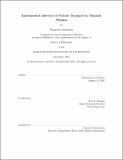Experimental Inference of Particle Transport in Tokamak Plasmas
Author(s)
Sciortino, Francesco
DownloadThesis PDF (13.60Mb)
Advisor
Marmar, Earl S.
Terms of use
Metadata
Show full item recordAbstract
The achievement of sustainable operation in tokamaks depends crucially on accurate understanding of fuel, impurity, and neutral particle dynamics. In this work, radial profiles of experimental particle transport coefficients have been inferred following laser blow-off (LBO) impurity injections into both Alcator C-Mod and DIII-D plasmas. Development of the Aurora modeling package has supported the creation of Bayesian frameworks that leverage a wide range of spectroscopic diagnostics. This investigation spans regimes without Edge-Localized Modes including Enhanced D-Alpha H-mode and I-mode on C-Mod, and diverted negative triangularity on DIII-D. On C-Mod, a novel forward model for the entire Ca K𝛼 spectrum has been combined with Extreme Ultra-Violet (EUV) spectroscopy of multiple charge states. On DIII-D, analogous EUV measurements complement Soft X-Ray and Charge Exchange Recombination spectroscopy. While the impact of Charge eXchange (CX) between impurities and background neutrals from heating beams is found to be relatively small, edge neutrals are shown to be extremely important for ionization balance and radiation in the pedestal region. This conclusion is supported by SOLPS-ITER simulations, shown to compare favorably to a database of Ly𝛼 measurements near the C-Mod midplane. We find neoclassical, gyrofluid, and nonlinear gyrokinetic modeling to be in relatively good agreement with experimental estimates of diffusion, whereas significant discrepancies in convection are evident in several cases. In particular, experimental observations of hollow impurity profiles often cannot be reproduced by microturbulence models within uncertainties, suggesting that current transport codes may be missing critical physics for impurity peaking predictions of future devices. As a whole, this work provides one of the highest-fidelity assessments of cross-field impurity transport in tokamaks, offering the means to extend comparisons between theory and experiments in the particle transport channel.
Date issued
2021-09Department
Massachusetts Institute of Technology. Department of PhysicsPublisher
Massachusetts Institute of Technology